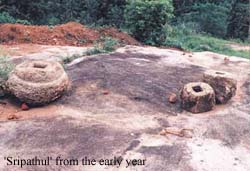
5th November 2000
News/Comment|
Editorial/Opinion| Business| Sports|
Sports Plus| Mirror Magazine

Old stones tell a tale
By Nilika de Silva
Construction work for a new Buddha statue coincidentally unearthed the old. The discovery of 13 stone inscriptions and other items of archaeological interest at the Korossa Raja Maha Viharaya, has sparked new interest in this ancient site, shedding beams of light on an era more than 1,800 years away. Situated
at Dodangaslanda, on the Kurunegala-Matale road, the Korossa temple is
believed to have been built during the Kandyan period by King Keerthi Sri
Rajasinghe. A stone inscription dating to the 18th Century was found near
the temple and in recent times, the site has turned up numerous items of
archaeological interest including many 'vaharala' inscriptions.
Situated
at Dodangaslanda, on the Kurunegala-Matale road, the Korossa temple is
believed to have been built during the Kandyan period by King Keerthi Sri
Rajasinghe. A stone inscription dating to the 18th Century was found near
the temple and in recent times, the site has turned up numerous items of
archaeological interest including many 'vaharala' inscriptions.
"There are stone inscriptions dating back to the Second Century A.D.," Director Exploration and Documentation, Department of Archaeology, Senarath Dissanayake said, adding that the site is even older.
The figures of dogs, crows and rat snakes (gerandi) are engraved on the vaharala inscriptions. Such inscriptions are often found close to the boundaries of temples as a sign that these lands are temple property, Mr. Dissanayake said. It is believed that any attempts to encroach on these lands would carry serious consequences and the animal forms are engraved to warn those who violate its sanctity that they would be reborn as animals, he said.
Artifacts from the Prehistoric period such as stone tools have been discovered here. Red ochre, a substance ground and used in the worship of deities, found on many archaeological sites has been discovered here too, as has pottery, both blackware and redware dating back to the 2nd Century AD. The 'sripathul' are from earlier years.
The temple's stone supports are remnants from a wooden structure and probably wooden pillars would have been mounted on these. Cisterns, similar to those often found at such sites were also seen. A stone inscription from the Polonnaruwa period was also found on nearby lands.
Excavation work has also turned up artifacts similar to those used in creating iron tools. Although there is no evidence as to how they were used, there are signs that tools have been made here as there are 'gal kovana' often found at iron production sites. A Bronze Age has not been found in Sri Lanka, said Mr. Dissanayake explaining how traces of the Stone Age civilisation lie alongside the Iron Age.
Chief Incumbent of the Korossa Raja Maha Viharaya, Ven. Galaboda Siddhaththa said one of the 'vaharala sel lipi' dated back to the Second Century AD, when Buddhism was new to Sri Lanka. The stone inscriptions include six belonging to the 2nd - 4th Centuries A.D., two from the 4th - 5th Centuries A.D. one from the 11th Century, Polonnaruwa Period, and another from the 18th century, the Kandy Period.
The Archaeology Department's Director Epigraphy and Numismatics, Dr. Malini Dias told The Sunday Times she was in the process of reading a very interesting 'vaharala' inscription probably dating back to the Second Century AD which described the area in which it was found. The name of the monastery is not stated, but donations given to the chetiya in the form of land have been recorded in this inscription, Mrs. Dias said.








![]()
Front Page| News/Comment| Editorial/Opinion| Plus| Business| Sports| Sports Plus| Mirror Magazine
Please send your comments and suggestions on this web site to

